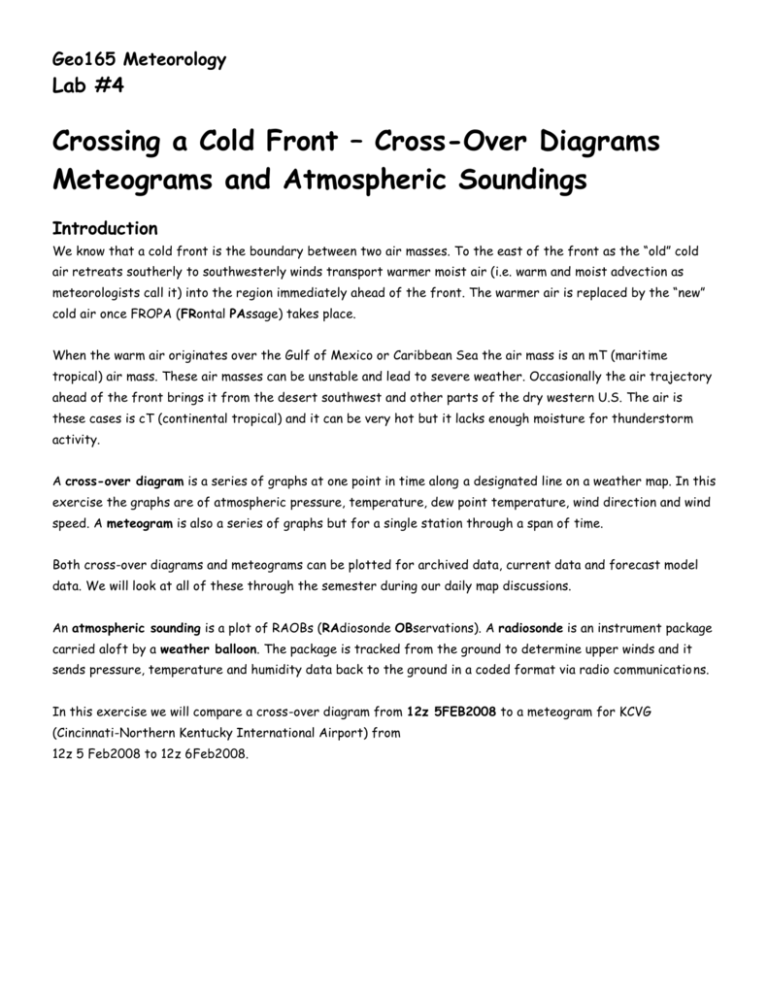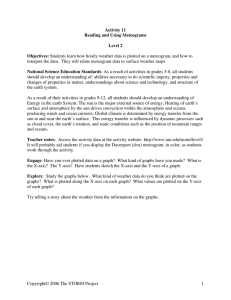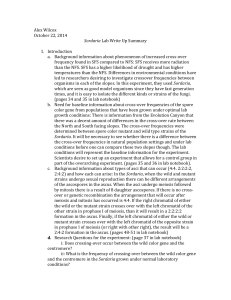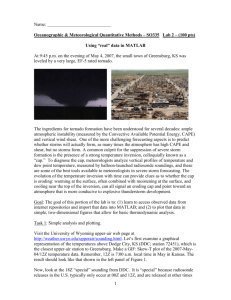Cross-Over Diagrams Meteograms and Atmospheric Soundings
advertisement

Geo165 Meteorology Lab #4 Crossing a Cold Front – Cross-Over Diagrams Meteograms and Atmospheric Soundings Introduction We know that a cold front is the boundary between two air masses. To the east of the front as the “old” cold air retreats southerly to southwesterly winds transport warmer moist air (i.e. warm and moist advection as meteorologists call it) into the region immediately ahead of the front. The warmer air is replaced by the “new” cold air once FROPA (FRontal PAssage) takes place. When the warm air originates over the Gulf of Mexico or Caribbean Sea the air mass is an mT (maritime tropical) air mass. These air masses can be unstable and lead to severe weather. Occasionally the air trajectory ahead of the front brings it from the desert southwest and other parts of the dry western U.S. The air is these cases is cT (continental tropical) and it can be very hot but it lacks enough moisture for thunderstorm activity. A cross-over diagram is a series of graphs at one point in time along a designated line on a weather map. In this exercise the graphs are of atmospheric pressure, temperature, dew point temperature, wind direction and wind speed. A meteogram is also a series of graphs but for a single station through a span of time. Both cross-over diagrams and meteograms can be plotted for archived data, current data and forecast model data. We will look at all of these through the semester during our daily map discussions. An atmospheric sounding is a plot of RAOBs (RAdiosonde OBservations). A radiosonde is an instrument package carried aloft by a weather balloon. The package is tracked from the ground to determine upper winds and it sends pressure, temperature and humidity data back to the ground in a coded format via radio communicatio ns. In this exercise we will compare a cross-over diagram from 12z 5FEB2008 to a meteogram for KCVG (Cincinnati-Northern Kentucky International Airport) from 12z 5 Feb2008 to 12z 6Feb2008. Important Concepts A front is the boundary of an air mass An air mass is a quasi-homogeneous body of air originating over a source region. – – The air mass acquires the characteristics of the source region surface with which it was in contact for a sufficiently long period of time to acquire those characteristics. As the air mass moves it is modified. Air that is warmer than the surface over which it is moving is stabilized (cTw for example) while air that is cooler than the surface over which it moves (cPk for example) is destabilized as it is warmer from below. Stabilization can lead to drizzle while destabilization can lead to showery weather. The leading edge of an advancing air mass is a cold front if polar or arctic air replaces warmer air. If warmer air is advancing into a region the front is a warm front. – – – – – Colder air is more dense and hugs the ground forcing warmer, less dense air to rise over it. Lab Materials lab4maps.pdf - Six weather maps from 12z 05Feb2008 Observations and front position Gridded wind barbs and front position Wind Streamlines and front position Gridded pressure and front position Gridded dew point temperature and front plot Gridded temperature and front plot lab4.xlsx – Excel data and graph spreadsheet Tasks Worksheet #1 – Sounding Data Worksheet #2 – Cross-Over Diagram data Worksheet #3 – Meteogram Diagram data We will walk through the procedures in class. Plot the soundings from ILX and ILN. Label indicators of the front. Plot a cross-over chart using the provided data from the maps. Indicate the frontal position. Plot a meteogram for CVG from the provided data, show when FROPA occurred. Answer the questions. Email the completed spreadsheet and question sheet as attachments to me @: steve@shorstmeyer.com subject line – THIS IS A MUST OR YOUR WORK MAY GET LOST - GEO165 printed work is not accepted for Lab#4 NAME________________________________________ Sounding Questions 1. There is an inversion well above the surface on the Lincoln, IL sounding. It is not present on the Wilmington, OH sounding. Explain how this indicates the front has passed through Lincoln but not Wilmington. 2. Label the cloud layers on each sounding? 3. Explain the difference in surface temperatures between Lincoln and Wilmington. Cross-Over Diagram Questions 4. What happens to atmospheric pressure as you cross the front traveling from SE to NW? Why? 5. What happens to the wind as you cross the front traveling from SE to NW? Why? 6. What happens to the temperature as you cross the front traveling from SE to NW? Why? 7. What happens to the dew point as you cross the front traveling from SE to NW? Why? Meteogram Questions 8. Compare the graph of pressure in the cross-over diagram to the graph of pressure in the meteogram. 9. What does the comparison tell you about using a cross-over diagram for forecasting? 10. Are the graphs of all the weather variables in both the cross-over diagram and the meteogram identical? What are the differences and why do










